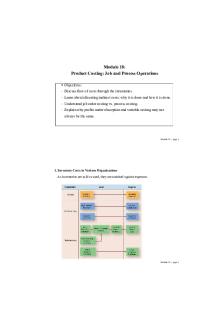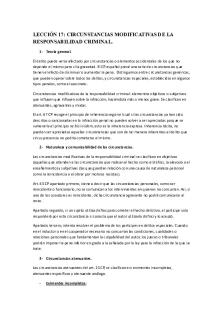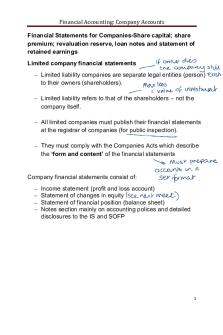Company Accounts - Lecture notes 17 - 18 PDF

| Title | Company Accounts - Lecture notes 17 - 18 |
|---|---|
| Author | Manoj Mason |
| Course | Financial Accounting |
| Institution | Manchester Metropolitan University |
| Pages | 19 |
| File Size | 817.1 KB |
| File Type | |
| Total Downloads | 81 |
| Total Views | 153 |
Summary
Company Accounts...
Description
Financial Accounting: Company Accounts Financial Statements for Companies-Share capital; share premium; revaluation reserve, loan notes and statement of retained earnings Limited company financial statements – Limited liability companies are separate legal entities (person) to their owners (shareholders). – Limited liability refers to that of the shareholders – not the company itself. – All limited companies must publish their financial statements at the registrar of companies (for public inspection). – They must comply with the Companies Acts which describe the ‘form and content’ of the financial statements
Company financial statements consist of: – – – –
Income statement (profit and loss account) Statement of changes in equity Statement of financial position (balance sheet) Notes section mainly on accounting polices and detailed disclosures to the IS and SOFP
1
Financial Accounting: Company Accounts The income statement: Companies use a summarised presentation for expense items: distribution costs administrative expenses investment income finance costs taxation The profit for the period (after tax) is the end of the income statement
2
Financial Accounting: Company Accounts Pro forma: company income statement Revenue Cost of sales
70 (40)
Gross profit
30
Distribution costs
(5)
Administrative expenses Investment income
(12) 2
Finance costs
(1)
Profit before tax
14
Income tax expense
(6)
Profit for the period
8
3
Financial Accounting: Company Accounts Statement of financial position: Most items are the same as for sole traders, companies are financed differently: - Share capital and reserves (equity); and - Borrowings (loan capital or debt) Pro Forma: Statement of Financial Position Assets
£
£
Non-current assets Land and buildings
45
Plant and machinery
35
Intangible – goodwill
10 90
Current assets Inventory
20
Receivables
25
Cash and bank
15 60
Total assets
150
4
Financial Accounting: Company Accounts Capital and liabilities Equity shares
30
Reserves: Revaluation reserve
20
Retained earnings
40
General reserves
10 70 100
Non-current liabilities – loan
10
Current liabilities Payables Accruals and provisions
35 5 40
Equity and liabilities
150
Note: under IFRS land and buildings and plant and machinery are normally aggregated to a single line of Property, plant and equipment (80 in above example)
5
Financial Accounting: Company Accounts Company financing: Share capital – two types: Ordinary (equity) and preference. Ordinary shares: Some terminology: Authorised share capital is the maximum amount of share capital that a company is permitted to issue (the issue capital may be less or equal to this amount). The authorised capital is not part of the double entry; it is in effect an item of disclosure. Nominal (or par) value is the amount written on share certificate (e.g. £1 or 25 pence) Issue price is the price the share is ‘sold’ at (may be at par or at a premium)
Example A company issues 200,000 shares £1 nominal value for £1.60 each. The journal for the transaction is:
Dr
Cr
Bank Ordinary shares Share premium (current) market value – is what a share is currently worth, normally means stock market value. This can change by the minute. 6
Financial Accounting: Company Accounts The market value is not recorded in the bookkeeping system, but it is important
Rights of equity shares: Entitled to the remaining (residue) profit after all other parties have had their entitlement. This is true whether or not the profit is actually paid out as dividends This means that all reserves (no matter what they may be for) are owned by the ordinary shareholders
Ordinary dividends: - cannot pay an ordinary dividend unless all preference dividends have been paid - ordinary dividends normally expressed as pence per share, but can be expressed as a percentage
Example (dividends per share basis)
A company has in issue £250,000 of equity shares made up of: 1,000,000 ordinary shares of 25p each The stock market price of each share is £1.50 7
Financial Accounting: Company Accounts An interim dividend of £20,000 has been paid The directors wish to propose a final dividend which will give a total dividend yield (interim plus final) equal to the sector average of 4%.
Solution
Preference shares: - entitled to a fixed dividend (e.g. 8%) in preference (priority) to ordinary dividends - dividends are (normally) ‘appropriations’ of profits, i.e. they are not an expense of the business (therefore not shown in the income statement) - they represent ‘distributions to owners’ - often paid in two equal parts: interim and final - preference shares may be cumulative or non-cumulative - they may be redeemable (dated): under new accounting standards these are now treated as debt with their dividends classed as finance costs - may be irredeemable (not dated): still treated as part of share capital with their dividends treated the same as ordinary share dividends - preference shares may be convertible at a future date to ordinary shares (treatment is complex) 8
Financial Accounting: Company Accounts - preference shares are also repaid in preference to ordinary shares in the event of a winding–up of the company.
Example of preference dividend A company has in issue: 4 million 12% preference shares of £1 each. Dividends are paid on 30 June and 31 December each year. How much is the dividend paid in the year ended 31 December 20X3?
9
Financial Accounting: Company Accounts Gallop is a retailing company; its trial balance at 31 March 20X1 is as follows: £’000 Ordinary shares of 25p each fully paid
£’000 100,000
8% Irredeemable preference shares
40,000
Retained earnings - 1 April 20X0
16,400
Revenue Purchases Administrative expenses Directors emoluments
224,500 128,000 12,900 3,400
Distribution costs
17,300
Land at cost and buildings at cost (land 15,000) Buildings depreciation - 1 April 20X0
90,000
Development expenditure at cost
20,000
45,000
Amortisation of development expenditure Plant and machinery at cost
8,000 125,000
Plant and machinery depreciation - 1 April 20X0
37,000
Trade payables
19,000
Trade receivables
20,400
Inventory - 1 April 20X0
31,900
Bank
600
Interim dividends paid (note vi) Bank interest paid
40,000 1,600 490,500
490,500
The following notes are relevant: (i) (ii) (iii)
(iv) (v) (vi) (vii)
Inventory was valued at cost of £24.5 million on 31 March 20X1. Land was revalued at £20 million on 1 April 20X0. The buildings are depreciated at 4% per annum on cost. Plant and machinery is depreciated by 15% per annum on the reducing balance basis. Development expenditure has a five year life. All depreciation/amortisation is to be treated as cost of sales. The directors are entitled to a yearend bonus payment of £400,000. The audit fee for the current year is estimated at £700,000. The interim dividends represent half of the preference dividend and an interim ordinary dividend. The final preference dividend for the year needs to be accrued for. A provision for income tax for the year ended 31 March 20X1 of £10.5 million is required.
10
Financial Accounting: Company Accounts Requirement: Prepare for Gallop for the year ended 31 March 20X1: (a) The income statement (b) The movement on retained earnings; and (c) A statement of financial position
11
Financial Accounting: Company Accounts Tutorial Question: Cheesebubble Limited has a trial balance at 31 December 20X4 is as follows: £’000
£’000
Ordinary shares of 50p each fully paid
50,000
12% Irredeemable preference shares
30,000
Retained earnings - 1 January 20X4
66,400
Revenue Purchases
390,400 231,000
Administrative expenses
42,900
Distribution costs
41,300
Land at cost and buildings at cost (land 40,000) Buildings depreciation - 1 January 20X4 Development expenditure at cost
120,000 30,000 50,000
Amortisation of development expenditure Factory equipment at cost
10,000 90,000
Factory equipment depreciation - 1 January 20X4
24,000
Trade payables
14,000
Trade receivables
41,600
Inventory - 1 January 20X4
29,600
Bank
1,400
Interim dividends paid (note vi)
40,000
Bank Loan Bank interest paid
80,000 7,000 694,800
694,800
The following notes are relevant: (i) (ii) (iii)
(iv) (v) (vi)
Inventory was valued at cost of £31.8 million on 31 December 20X4. Land was revalued to £50 million on 1 April 20X0. The buildings are depreciated at 2% per annum on cost and this is charged to admin expenses. Plant and machinery is depreciated by 20% per annum on the reducing balance basis and charged to cost of sales. Development expenditure has a 10 year life and is charged to admin expenses. The interim dividends represent half of the preference dividend and an interim ordinary dividend. The final preference dividend for the year needs to be accrued for. An accrual of £4.2 million is required for bank interest. A provision for income tax for the year ended 31 December 20X4 of £12.4 million is required.
12
Financial Accounting: Company Accounts Requirement: Prepare for Cheesebubble for the year ended 31 December 20X4: (a) The income statement (b) The movement on retained earnings; and (c) A statement of financial position
13
Financial Accounting: Companies Part II Company Accounts Part II: 1. Reserves 2. Debentures and loan stock 3. Statements of changes in equity 1: Reserves (a) Capital Reserves: Cannot pay a dividend from them • Share Premium Account • Revaluation Reserve
(b) Revenue Reserves • Retained Earnings (Profit and Loss account) • General Reserve
1
Financial Accounting: Companies Part II 2: Debentures and Loan Stock • Pieces of paper issued by companies in exchange for cash. • Interest is paid on the debenture/loan stock and charged to the income statement. • Types of debenture/loan stock: o Irredeemable o Redeemable o Convertible o Non-convertible Example: Mowtchops plc issues £5 million of 8% loan stock on 1 January 20X3. Interest is paid on 31 December each year. At 1 January 20X3 Mowtchops has operating profit of £3.2 million, 5 million ordinary £1 shares and retained profits of £8.6 million The loan stock is: (a) Redeemable (b) Irredeemable
2
Financial Accounting: Companies Part II Redeemable Debentures £’000
Irredeemable Debentures £’000
£’000
£’000
Income Statement Operating profit Interest payable Profit before tax Tax Profit after tax Statement of financial position Liabilities: 8% loan stock Equity: £1 Ordinary shares 8% preferred stock Retained earnings (W1) Retained Earnings At 1 January 20X3 Profit after tax Dividends paid At 31 December 20X3
3
Financial Accounting: Companies Part II 3: Statement of Changes in Equity (SOCIE) • This shows all the headings that appear as equity in the statement of financial position, and how they have moved in the year. Example: During the year ended 31 December 20X2, Slice plc had the following transactions: • • • •
15,000 £1 ordinary shares issued at £2.40 each. Land revalued from £120,000 to £150,000. Profit after tax of £81,000. Dividends paid of £27,000
1 January 20X2 Share issue
£1 Share Revaluation ordinary Premium Reserve shares 40,000 24,000 18,000
Retained Total Earnings 56,000
138,000
Revaluation Profit for year Dividends paid 31 December 20X2
4
Financial Accounting: Companies Part II Supertutorial Question: Bowdon Ltd is a wholesale company; its trial balance at 31 March 2011 is as follows: £ Ordinary shares of 50p each fully paid 8% Loan notes (issued 2007) Retained earnings - 1 April 2010 Land and buildings at cost (land element £40,000) Buildings depreciation - 1 April 2010 Plant and machinery at cost Plant and machinery depreciation - 1 April 2010 Trade payables Trade receivables Inventory - 1 April 2010 Revenue Purchases
£ 70,000 40,000 18,000
120,000 20,000 85,000 35,000 29,500 30,000 27,500 210,000 114,000
Returns outwards Administrative expenses
21,000
Selling and distribution costs Dividends paid
16,500 13,000
Bank Loan interest paid
2,500
3,600 1,600 428,600
428,600
The following notes are relevant: (i) (ii) (iii) (iv) (v) (vi)
Inventory was counted and valued at cost of £35,000 on 31 March 2011. £5,000 (at cost) of the stock had a net realisable value of only £3,500. The buildings are depreciated over a 20 year life. Plant and machinery is depreciated at 15 % per annum on the reducing balance basis. All depreciation is to be treated as cost of sales. An allowance for doubtful receivables of 2% needs to be made which should be included in selling and distribution costs. Included in administrative expenses, was an amount of £9,000 for an annual insurance premium that runs to 31 July 2011. Provide for the outstanding interest on the loan notes. A provision for corporation tax for the year ended 31 March 2011 of £17,500 is required.
Required: for the year ended 31 March 2011, prepare for Bowdon Ltd: a) The income statement b) The movement on retained earnings; and c) A statement of financial position
(16 marks) (3 marks) (16 marks) Total 35 marks
5
Financial Accounting: Companies Part II
6...
Similar Free PDFs

Lecture 7 company accounts
- 2 Pages

Company Accounts notes
- 26 Pages

18 - Lecture notes 18
- 5 Pages

T-accounts - Lecture notes 69
- 2 Pages

Chapter 18 - Lecture notes 18
- 21 Pages

Chapter 18 - Lecture notes 18
- 14 Pages

Module 18 - Lecture notes 18
- 41 Pages

Chapter 18 - Lecture notes 18
- 26 Pages

LecciÓn 17 - Lecture notes 17
- 6 Pages

Chapter 17 - Lecture notes 17
- 15 Pages

Chapter 17 - Lecture notes 17
- 7 Pages

Research 18 - Lecture notes 18
- 5 Pages

Chapter 18 - Lecture notes 18
- 13 Pages

Company Law Lecture Notes
- 56 Pages
Popular Institutions
- Tinajero National High School - Annex
- Politeknik Caltex Riau
- Yokohama City University
- SGT University
- University of Al-Qadisiyah
- Divine Word College of Vigan
- Techniek College Rotterdam
- Universidade de Santiago
- Universiti Teknologi MARA Cawangan Johor Kampus Pasir Gudang
- Poltekkes Kemenkes Yogyakarta
- Baguio City National High School
- Colegio san marcos
- preparatoria uno
- Centro de Bachillerato Tecnológico Industrial y de Servicios No. 107
- Dalian Maritime University
- Quang Trung Secondary School
- Colegio Tecnológico en Informática
- Corporación Regional de Educación Superior
- Grupo CEDVA
- Dar Al Uloom University
- Centro de Estudios Preuniversitarios de la Universidad Nacional de Ingeniería
- 上智大学
- Aakash International School, Nuna Majara
- San Felipe Neri Catholic School
- Kang Chiao International School - New Taipei City
- Misamis Occidental National High School
- Institución Educativa Escuela Normal Juan Ladrilleros
- Kolehiyo ng Pantukan
- Batanes State College
- Instituto Continental
- Sekolah Menengah Kejuruan Kesehatan Kaltara (Tarakan)
- Colegio de La Inmaculada Concepcion - Cebu

